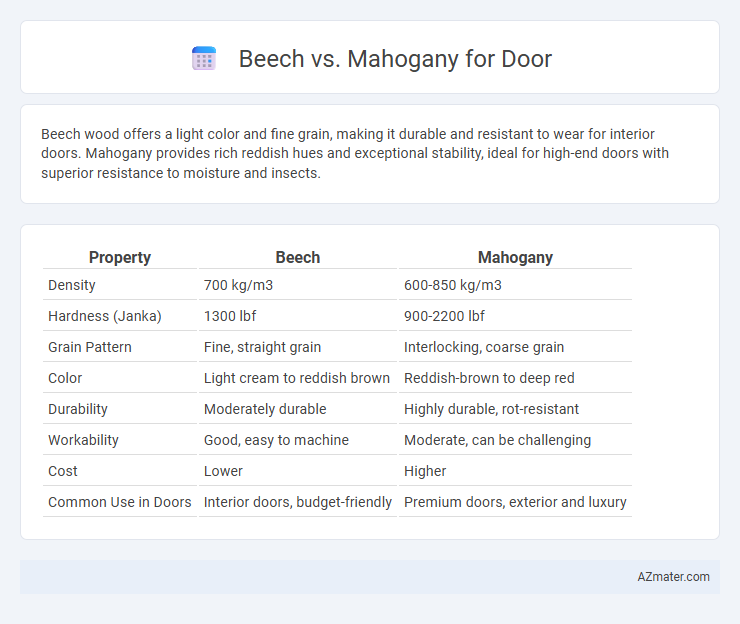Beech wood offers a light color and fine grain, making it durable and resistant to wear for interior doors. Mahogany provides rich reddish hues and exceptional stability, ideal for high-end doors with superior resistance to moisture and insects.
Table of Comparison
| Property | Beech | Mahogany |
|---|---|---|
| Density | 700 kg/m3 | 600-850 kg/m3 |
| Hardness (Janka) | 1300 lbf | 900-2200 lbf |
| Grain Pattern | Fine, straight grain | Interlocking, coarse grain |
| Color | Light cream to reddish brown | Reddish-brown to deep red |
| Durability | Moderately durable | Highly durable, rot-resistant |
| Workability | Good, easy to machine | Moderate, can be challenging |
| Cost | Lower | Higher |
| Common Use in Doors | Interior doors, budget-friendly | Premium doors, exterior and luxury |
Introduction: Beech vs Mahogany Doors
Beech and mahogany are two popular hardwood choices for doors, each offering distinct characteristics in terms of durability, grain, and aesthetic appeal. Beech features a fine, tight grain pattern with a light, pale cream color that darkens with age, making it ideal for modern and minimalist door designs. Mahogany is prized for its rich, reddish-brown hue and exceptional resistance to rot and decay, providing a luxurious and long-lasting option for traditional or high-end doors.
Wood Characteristics: Beech and Mahogany
Beech wood boasts a fine, tight grain with a light cream color that darkens slightly over time, offering excellent hardness and wear resistance ideal for door applications. Mahogany features a straight, coarse grain with a rich reddish-brown hue, prized for its stability, durability, and natural resistance to decay in door construction. Both woods provide strength and aesthetic appeal, but beech's uniform texture contrasts with mahogany's distinctive warmth and patina, influencing choice based on design and environmental factors.
Durability and Strength Comparison
Beech wood exhibits high durability and moderate strength, making it resistant to wear and suitable for interior doors subject to regular use. Mahogany, known for its superior strength and excellent resistance to decay, offers long-lasting performance especially in environments exposed to moisture and varying temperatures. When choosing door materials, mahogany provides enhanced structural integrity, while beech delivers reliable durability for everyday applications.
Aesthetic Appeal and Grain Patterns
Beech doors offer a smooth, fine grain with a light, creamy color that enhances modern and minimalist interiors, providing a uniform and subtle texture. Mahogany doors are prized for their rich, deep reddish-brown hues and striking, interlocking grain patterns that exude warmth and luxury, making them ideal for classic or traditional designs. The distinct aesthetic appeal and intricate grain variations of mahogany create an opulent, timeless look, whereas beech delivers a clean, consistent surface that suits contemporary spaces.
Cost Differences: Beech vs Mahogany
Beech doors generally cost less than mahogany doors due to the faster growth rate and greater availability of beech wood. Mahogany is priced higher because of its durability, rich color, and the slower maturation period of the tree, which impacts supply. Choosing beech can reduce upfront costs, while mahogany offers long-term value through its strength and aesthetic appeal.
Maintenance and Longevity
Beech doors require moderate maintenance due to their susceptibility to moisture and warping, often needing regular sealing or varnishing to maintain durability. Mahogany doors offer superior longevity and resistance to rot and insect damage, making them ideal for high-traffic or exterior applications with minimal upkeep. Choosing mahogany ensures a longer-lasting door with less frequent maintenance compared to beech.
Suitability for Interior and Exterior Doors
Beech wood offers a fine grain and moderate hardness that makes it suitable for interior doors due to its smooth finish and ease of staining, providing a warm aesthetic. Mahogany is highly durable and naturally resistant to rot and insects, making it an excellent choice for exterior doors exposed to weather elements. While Beech is better suited for indoor use because of its lower moisture resistance, Mahogany's dense structure ensures longevity and stability in both interior and exterior applications.
Environmental Impact and Sustainability
Beech wood, sourced primarily from European forests with sustainable management certifications like FSC, has a faster growth rate and higher carbon sequestration compared to slow-growing mahogany, making it more environmentally friendly. Mahogany, often harvested from tropical rainforests, faces challenges with deforestation and habitat loss, though certified plantations can mitigate these effects. Choosing beech for doors supports reduced environmental impact through responsible forestry and promotes sustainability by utilizing a rapidly renewable resource.
Popular Uses and Design Trends
Beech and mahogany are popular choices for doors, each favored for distinct design trends and uses. Beech is commonly used in modern interiors for its light color, smooth grain, and durability, making it ideal for minimalist and Scandinavian-style doors. Mahogany, prized for its rich, deep reddish-brown hue and natural resistance to moisture, is preferred in classic, luxury, and traditional door designs, often seen in upscale residential and commercial projects.
Choosing the Right Wood for Your Door
Beech wood offers a hard, dense grain with excellent shock resistance, making it ideal for interior doors that require durability and a smooth finish. Mahogany, prized for its rich color and natural resistance to rot and insects, is a premium choice for exterior doors where weather resistance and aesthetic appeal are crucial. Choosing the right wood for your door depends on balancing factors such as durability, moisture resistance, and visual style, with Beech favored for cost-effective strength and Mahogany preferred for luxury and long-lasting exterior performance.

Infographic: Beech vs Mahogany for Door
 azmater.com
azmater.com